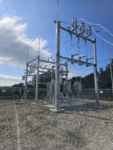SPP board approves new planning reserve margins to protect against higher energy use in winter and summer
LITTLE ROCK, ARK. — At their August 5-6 meetings, Southwest Power Pool’s (SPP) Regional State Committee and Board of Directors approved increases to the planning reserve margins (PRM) member utilities are required to maintain in support of regional grid reliability. PRM represents the amount of back-up power utilities must have to guard against unplanned conditions or events on the regional power grid.
SPP’s action will further help the region prepare for extreme weather events and other circumstances that lead to higher-than-usual demand for electricity. Such episodes have become increasingly common in recent years, such as with Winter Storm Uri in 2021 and Winter Storm Elliott in 2022.
SPP’s Regional State Committee and board approved minimum requirements of a 36% winter-season PRM and a 16% summer-season PRM, effective beginning summer 2026 and winter 2026/27. This means that load responsible entities in SPP’s region must have access to enough generating capacity to serve their peak consumption with at least 36% margin during the winter season and at least 16% margin during the summer.
This action marks the first time a winter PRM requirement has been defined separately from SPP’s summer PRM requirement and was taken to ensure member utilities appropriately acquire enough generating capacity for both seasons. The current 15% summer PRM requirement was previously applied to the winter season also. The new requirements support SPP’s efforts to reliably and continuously meet the region-wide demand for electricity from residents, commercial centers and industries throughout the SPP footprint.
The board also received a report detailing the challenges SPP and its members face with the increasing risk of having inadequate electricity supply to meet demand. The report, titled Our Generational Challenge: A Reliable Future for Electricity, is a comprehensive summary of SPP’s work to leverage diverse energy resources to meet the ever-rising demand for electricity. It calls for increased engagement, collaboration and consensus among government energy regulators, elected policymakers, utilities, regional transmission organizations and customers.
“As the real-time grid operator and transmission planner for a 14-state region, our job is to ensure electric reliability for millions of consumers. We’ve been successfully doing this work since 1941. But we can’t do it alone. A concerted, collective effort is needed to ensure we have a reliable power grid today and in the future,” said SPP Chief Executive Officer Barbara Sugg in the report’s opening statement. The report and an infographic are available at spp.org/ourchallenge. Sugg further pointed out that SPP is increasingly forced to issue grid advisories in winter and summer due to the heightened risk of inadequate power supplies during those times. She said harnessing enough energy to meet demand has become more and more complicated due to the rapidly evolving power grid. “Demand for electricity is outpacing supply from our generation fleet,” Sugg said. “While SPP always focuses on affordability, we need continued investment to add the generating and transmission facilities needed to mitigate risks and keep the lights on.”
About SPP: Southwest Power Pool, Inc. is a regional transmission organization: a not-for-profit corporation mandated by the Federal Energy Regulatory Commission to ensure reliable supplies of power, adequate transmission infrastructure and competitive wholesale electricity prices on behalf of its members in 14 states. SPP ensures electric reliability across a region spanning parts of the central and western U.S., provides energy services on a contract basis to customers in both the Eastern and Western Interconnections, and is expanding its RTO and developing a day-ahead energy market in the west. The company’s headquarters are in Little Rock, Arkansas. Learn more at SPP.org


